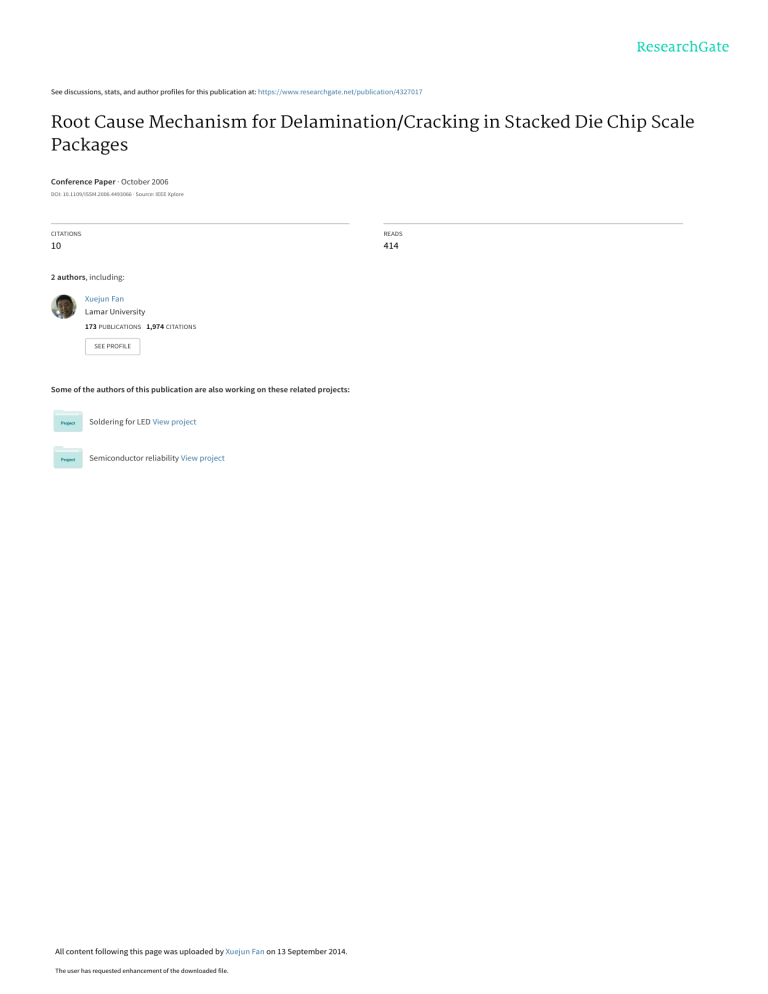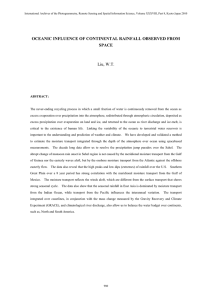Root Cause Mechanism for Delamination-Cracking in Stacked Die Chip Scale Packages
advertisement

See discussions, stats, and author profiles for this publication at: https://www.researchgate.net/publication/4327017 Root Cause Mechanism for Delamination/Cracking in Stacked Die Chip Scale Packages Conference Paper · October 2006 DOI: 10.1109/ISSM.2006.4493066 · Source: IEEE Xplore CITATIONS READS 10 414 2 authors, including: Xuejun Fan Lamar University 173 PUBLICATIONS 1,974 CITATIONS SEE PROFILE Some of the authors of this publication are also working on these related projects: Soldering for LED View project Semiconductor reliability View project All content following this page was uploaded by Xuejun Fan on 13 September 2014. The user has requested enhancement of the downloaded file. FM Root Cause Mechanism for Delamination/Cracking in Stacked Die Chip Scale Packages - 224 Edward R. Prack and Xuejun Fan Intel Corporation Chandler, Arizona, United States edward.r.prack@intel.com Abstract - A key challenge in the development of ultra-thin stacked die chip scale packages is to meet package performance requirements without delamination. Interfacial delamination and cohesive failure are particular concerns. The root cause of this type offailure is difficult to discern, even with extensive root cause analysis andfocused DOEs. Through comprehensive simulation and material characterization, three key parameters were identified which affected the package performance, i.e., substrate thickness, reflow time and substrate diffusivity. The root cause model established the relationship between moisture uptake, material properties such as diffusivity andporosity, and vapor pressure buildup. Two scenarios with regard to package behavior during soldering reflow are predicted. INTRODUCTION A key challenge for developing ultra-thin stacked-die chip scale packages (CSP) is to meet the package reliability requirements without delamination in the package. The higher reflow temperature required for lead-free packaging results in increased reliability concems for these plastic packages. Figure 1. After L3 preconditioning, massive cohesive delamination was seen in the first layer of die attach film (film 1). The cohesive delamination is a consequence of void growth and coalescence induced by vapor pressure during the reflow process. Cohesive delamination has been observed in the first layer of die-attach film (film 1), as seen in Figure 1. Failures were detected by TSAM after Level 3 pre-conditioning. The preconditioning involves soaking at the constant temperature/moisture, and then to a reflow process. The failure rate depends on the reflow profiles even with the same peak temperature at 2600C. Figure 2 illustrates different reflow profiles, both satisfying JEDEC standard. The delamination rate was dramatically less in the FM case versus the SH case. 0 25 50 75 100 125 150 175 200 225 250 275 300 325 350 375 400 ..... 260 240 240 ~ - 220 -. a 220 200..... 200 180 140 _ 140 .1 ~~~~~~~~~~.....120 120 100 80 100 80 60 40- 7;---t; / -- --1 ----l ~~~~~~~SH -20 20 0 60 -FM 40 l; 25 50 75 100 125 150 175 200 225 250 275 300 325 350 375 400 time (s) Figure 2. Two reflow profiles both meet the JEDEC standard. The main difference is that FM one ramps much slower up to the temperature peak compared to SH one. PACKAGE MATERIAL PROPERTIES AS A FUNCTION OF MOISTURE The effect of moisture on material properties and moisture transport in package materials were evaluated. The properties of the die attach material were examined. Figure 3 plots the Young's Modulus of die attach film as function of temperature with and without moisture. It can be seen that the Tg drops significantly after moisture absorption. Figure 4 shows the moisture weight gain curve for a 30pm die attach film at 30°C/70RH%. It shows that the film is saturated within 5 minutes even at room temperature. The diffusivity at the reflow temperature (e.g. 260°C) is an order higher than the data in literature (e.g. [1], [2]). This is an important finding because it implies that moisture escape plays a more significant role then indicated by the ambient diffuisivity data. 900 800 700 Dfi 6002 500 en 3 400 0 300 200 100 - I - -4-No RH -*-85 -5 -I % RH O- After a careful review of the failure in the die attach material and various DOEs to attempt to determine root case a new approach was examined. It was postulated that the failure was the result of vapor pressure exceeding the strength of the materials and interfaces in the package. To evaluate this theory the moisture properties of the packaging materials were determined and the stress levels in the package were modeled. 0 20 40 60 80 Temperature (°C) 100 120 Figure 3. Modulus as function of temperature for DA film 219 140 0.4 the die attach film 1 are fully saturated for different substrates. The above results show that the initial moisture concentration in die attach film 1 (area enclosed by dashed line, thickness being exaggerated for visual clarity) is same for both substrates right after soaking. From the moisture contour plot, it can also be observed that moisture diffuses very slowly in the molding compound (MC). Therefore, inside film 1 moisture is mainly from the diffusion through the substrate, and other layers of die attach film is from molding compound. - 0.3- .r- 0.2- 0. 1 CD 3 n - - -0. 1 time (minute) Saturated Figure 4. 30um die attach film moisture weight gain curve at 30°C/70RH% Figure 5 plots the saturated moisture concentration at 60RH% and 30RH% with various temperatures. It confirms that the saturated moisture concentration for BT material is independent of temperature level up to 80°C. Figure 6. After 96 hr 60°C/60% Precon, film 1 is saturated in both the 2-L substrate and 4-L substrate. Other layers of film are dry due to the moisture blocking Si, provided the other film layers initially are dry. 11 m Eu 8 E co 6 U) 4 7-pm BTcoreOR.H. | 0 80% R.H.| 70 pm BT core 70 80 60 50 Temperature (0C) Figure 5. Saturated moisture concentration as function of temperature 30 40 Figure 7. Schematic of diffusion path during reflow (not to scale for visual clarity). Initial tiny voids acting like water reservoir giving high vapor pressure which may cause cohesive delamination during reflow. Representative plastic package material moisture diffusivity and solubility constants are listed in Table 1. Table 1. Material properties at 60°C/60RH SR DA BT-C Film ore Diffusivity (10-'2m2/s) 29.3 0.514 1.3 0.152 Solubility (104 kg/m3.pa) 3.92 3.92 13.3 2.08 MC During reflow, the moisture absorbed during soaking acting like water reservoir (Figure 7). At high reflow temperature, water vaporizes giving high vapor pressure, which may lead to cohesive delamination. At the same time, it escapes by diffusion. Two scenarios of vapor pressure build up can predicted. These two scenarios are illustrated in Figures 8 and 9, respectively. \4.69MPa > film MOISTURE MODELING RESULTS (MOISTURE CONCENTRATION AND VAPOR PRESSURE) E Vapor pressure is directly related to temperature and moisture concentration which may decrease during reflow due to moisture diffusion out of the package. In this section, the moisture diffusion is used to explain the drastic delamination performance for different types of substrate. The details of the model are not discussed, only the results which incorporated the materials properties noted in the earlier section. Figure 6 shows the moisture distribution after 96 hours for different substrates. The results show that the substrate and 220 strength 240 210 180 150 120 90 0 60 120 180 reflow time (second) 240 300 Figure 8. Scenario 1: vapor pressure buildup during reflow Failure happens at high temperature where polymer has a larger CTE, thermal stress and hydrothermal stress inside the film are ---V Pa _ both compressive because the polymer expansion is 210 constrained by the surrounding materials with relatively higher 0 48MP ° 180 [ £|£! Xg~~~~~~~~~~~~~~~~~~~~~~~~~~~~~~~~~ stiffness. It is unlikely for a material under compression to 150 voids based on the cavitation theory. Meanwhile, the grow X 120-_ _ IReflw P01%oll orotlei thermal stress and hydrothermal stress level inside the film is E --.U limited the film modulus. A reasonable elastic deformation, by 60 say 3% strain, gives only -0.03MPa. The finite element modeling confirmed the thermal stress inside the film is 4120 180 240 300 0 60 compressive and on the order of O0.0lMPa, which is far reflow time (second) smaller than the saturation vapor pressure 4.7MPa at 2600C. The moisture may diffuse out of the package during reflow. If Figure 9. Scenario 2: vapor pressure buildup during reflow 50% moisture is lost, the pressure still can be a few MPa, still much larger than the stress level by CTE mismatch and The delamination performance difference lies in the moisture hydrothermal stress. So the CTE mismatch and hydrothermal loss during the reflow process. If the diffusion time scale T is stress effect can be neglected safely. Past results showed that if much shorter than the reflow time, moisture can diffuse out of a substrate did not go through the soaking procedure, there was the package for both substrates; if the diffusion time scale V no delamination after reflow. Therefore, it can be concluded is much larger than the reflow time, moisture can not diffuse that the failure driving force is water vapor pressure at the high out of the package for both substrates. If either of the above temperature. scenarios is true, then moisture escape through the substrate can not explain the substrate dependent delamination For a reasonable initial void size Al,n, the deformation falls performance difference between the different substrates. Only into the elasticity controlled regime. The saturation vapor when the diffusion time scale is comparable to the reflow time, pressure (a few MPa) and low modulus of the film (1-2MPa) should the moisture diffusion be a concern during reflow. The satisfy the cavitation condition, therefore, film may fail most diffusion resistant organic material inside the substrate is cohesively if the moisture concentration is high enough inside BT core. Hence, for thicker substrate, it takes more time to the film. escape same amount of moisture to decrease the vapor pressure to a safe level and shows higher delamination rate. VALIDATIONS The moisture diffusion analysis also explains there is no cohesive delamination in other layers of film. Other layers of A controlled experiment varying the material die attach films are sandwiched by dies, so the moisture components was evaluated to determine thesubstrate effect on moisture absorbed during soaking is far from saturation. If the initial related reliability performance. A substrate contains Solder moisture level is low, there should be of no cohesive Mask (SM)/BT core/Copper layer (Figure 1 1). The following delamination. parameters were varied (1) BT core thickness to study the Figure 10 plots the ratio of moisture concentration over the thickness effect of the diffusion path on the delamination. (2) saturated moisture concentration in the die attach film. About SM thickness to check its high solubility effect which makes 80% of the total saturated moisture can be lost in 6 minutes it as a moisture reservoir. After fast preconditioning, the during reflow. There exists a critical moisture concentration, delam rate is monitored by TSAM. above which the delamination will occur. The diffusivity D, substrate thickness and reflow time are three critical Out Iv parameters to control the residual moisture level in die attach material. 270 240 1-1 \ I". >., -l . - film strength I_.. f- - a 90 - 30 0 ~l . 0.8 ;E-^, ;X:; : ;y : y g; :: il Figure 11. Schematic of substrate ~~~~~~~Pa; 0.2 60 120 180 U ---- 1x micro n 0.6 0 "4 _ 240 300 Table 2 clearly demonstrates that the thicker the BT-core, the higher the delamination rate (Leg 1-4). The BT-core acts like a strobe controlling the moisture diffusion from film 1 out of the package. SM has higher solubility which accumulates more water during soaking. This explains even the BT-core thickness for Leg 5 is close to Leg3,4, it still has the highest delamination 360 Time (seconds) Figure 10. Moisture loss during reflow rate. 221 Table 2. Delamination rate for different substrate design. Thickness (gm) LegI Leg 2 Leg 3 Leg 4 Leg 5 Solder Mask lx 1.02x 1.04x 1.04x 1.37x Inner Cu density 0% 500% 500% 500% 500% Moisture bakeout procedures should use JEDEC standards [9] as a baseline and tailor the queue time to the material properties to attain processes with good EOL yield. For materials that absorb moisture quickly and are subsequently encapsulated by a more impervious material there is the risk of trapped moisture that can result in EOL delamination. BT-Core ly 1.09y 1.43y 1.47y 1.44y Conclusions Total lz 1.20z 1.47z 1.47z 1.53z Delam Rate 0% 7% 32% 47% 100% The expansion of moisture in plastic packages during reflow results in large amounts of stress being generated in the package, and at the same time, a significant reduction of adhesion strength, which can result in delamination in the package. Thus an understanding of the moisture diffusion rates and maximum moisture loading for materials in plastic packages is important to attaining high reliability packages that do no delaminate at EOL or in reliability. Careful selection of package materials to minimize moisture uptake and maximize diffusion rates would improve package performance. Careful consideration of the moisture properties of the materials in the package is also important since this can affect the understanding of how moisture can be trapped in the packaged due to poor control of complete encapsulation of more absorbent materials before they can desorb moisture in the molding process if the encapsulant has high impedance to moisture release. Each leg sample size 240. relative thickness values shown (x-soldermask, y-BT core, z-total substrate thickness). As shown in Figure 2, FM profile ramps to the temperature peak much slower than SH profile does. The slow ramp period from time Os to 270s acts as an in-line baking prior to the temperature peak. More moisture will diffuse out of the package through the substrate for Folsom profile, which can significantly reduce the vapor pressure at the temperature peak. The understanding supports the delamination rate difference observed between -7% for FM profile and -80% for SH profile. DISCUSSION An important consideration is the cohesive strength of the DA materials in the package as it relates to the stress in the package induced by mechanical/material/moisture effects. If any of the materials in the package have lower cohesive strength than the stresses imposed during reflow there will be a risk of cohesive failure during reflow. When the materials have high modulus (e.g. > 5OMPa), the cohesive failure has never been a concem. Instead, the failure always occurs at the interface [3], [4]. In that case, the adhesion strength at elevated temperature with moisture is a critical indicator for the package performance. However, for the materials with modulus at high temperature in the range of the saturated vapor pressure (4.7MPa at 260°C), the residual moisture concentration and the void size become the most critical indicators for reflow performance. The vapor pressure becomes a dominant driving force for the cohesive failure. For thicker substrate packages the moisture loss along the substrate/DA material interface may not be significant during reflow, though significant amount of moisture in the exterior of package might be lost. However, for ultra-thin package with thinner substrate thickness there will be a significant moisture loss in DA materials. The thin package with very soft DA adhesive is very sensitive to the residual moisture and the reflow time. A few minutes bake could completely dry the package out. This is fundamentally different from thicker packages, where it takes a few hours or days to dry out the package. In addition to the reliability related moisture effects described earlier there are also process related effects that show high correlation to moisture related phenomena. A key parameter that requires careful control is moisture bakeout and the queue time following moisture bakeout. This is particularly true for packaging materials that have fast moisture uptake rates. 222 View publication stats ACKNOWLEDGMENTS The authors would like to acknowledge the work and many useful discussions with MIFFT (moisture induced failure focus team) team members. Specifically Ibrahim Bekar, Anthony Fischer, Yi He, Jianfeng Wang, Zhenyu Huang. This was a truly' cross functional team incorporating members and inputs from sites in Chandler, Az, Folsom, Ca and Shanghai, China. REFERENCES [1] J.E. Galloway, and B.M. Miles, 'Moisture Absorption and Desorption Predictions for Plastic Ball Grid Array Packages', IEEE Transactions on Components, Packaging and Manufacturing Technology, Part-A, 20(3), pp 274-279 (1997) [2] E.H. Wong, R. Rajoo, 'Moisture absorption and diffusion characterization of packaging materials-advanced treatment', Microelectronics Reliability 43, pp 2087-2096 (2003) [3] D. Hagen, E. Prack, Z. Tran, 'Effect of molding compound/polyimide interface chemistry on TSOP delamination', IEEE/CHMT Int Electronics Manufacturing Technology Symposium (1993) [4] X.J. Fan, G.Q. Zhang, W.D. van Driel and J. Zhou, 'Modeling and characterization of moisture behavior ', chapter in book by G.Q. Zhang, W.D. van Driel and X.J. Fan 'Mechanics of Microelectronics' Springer (2006)





